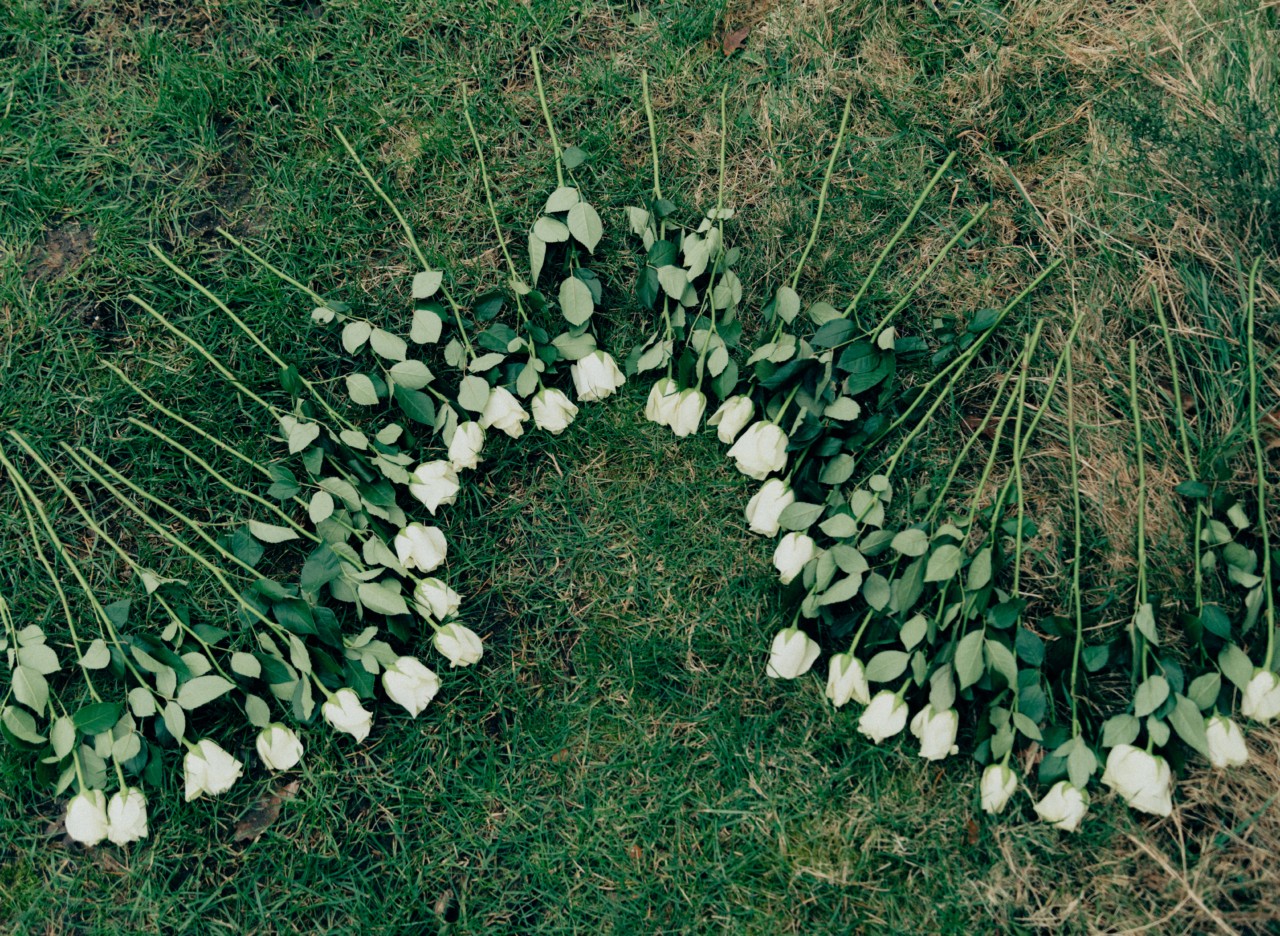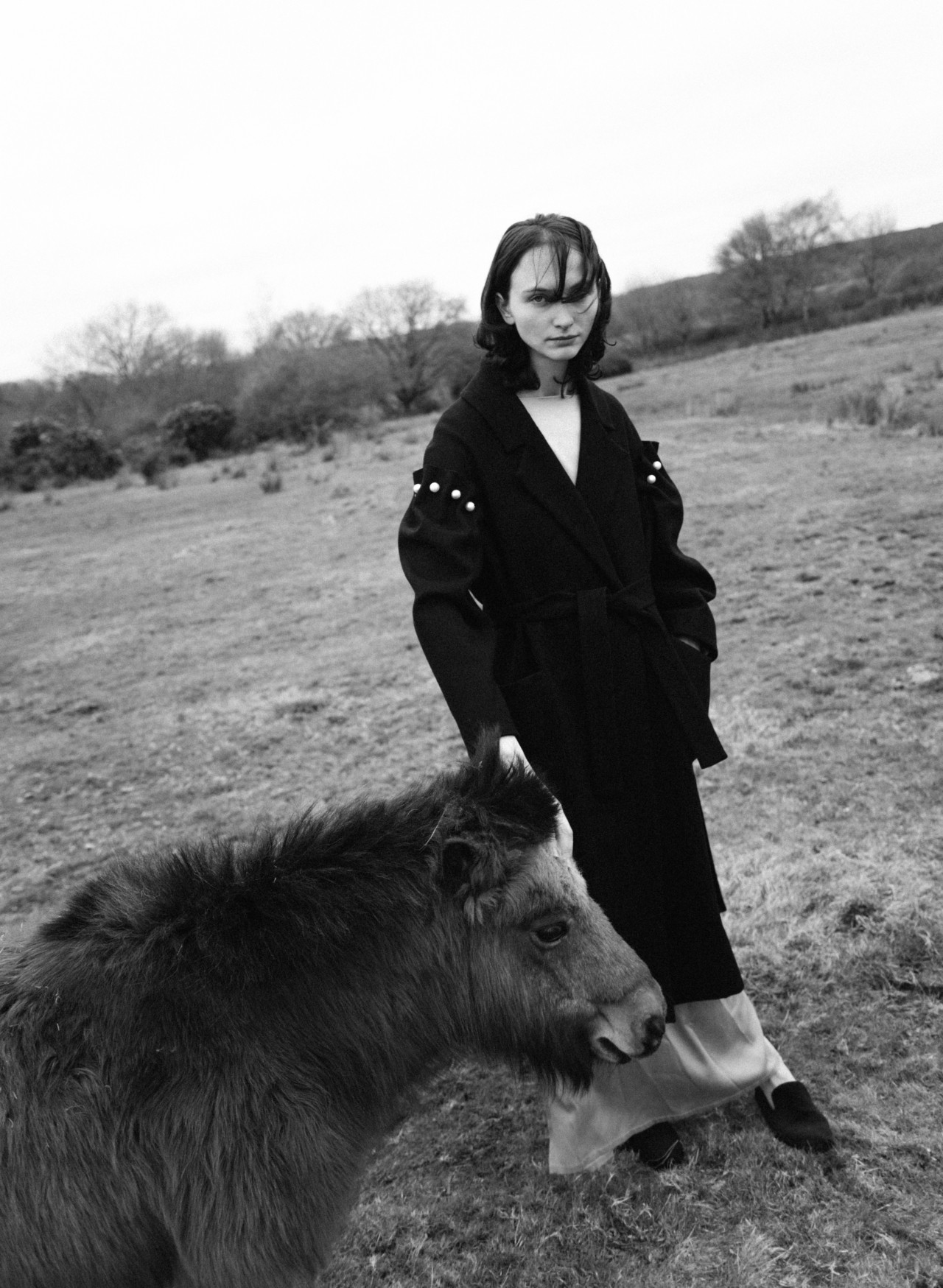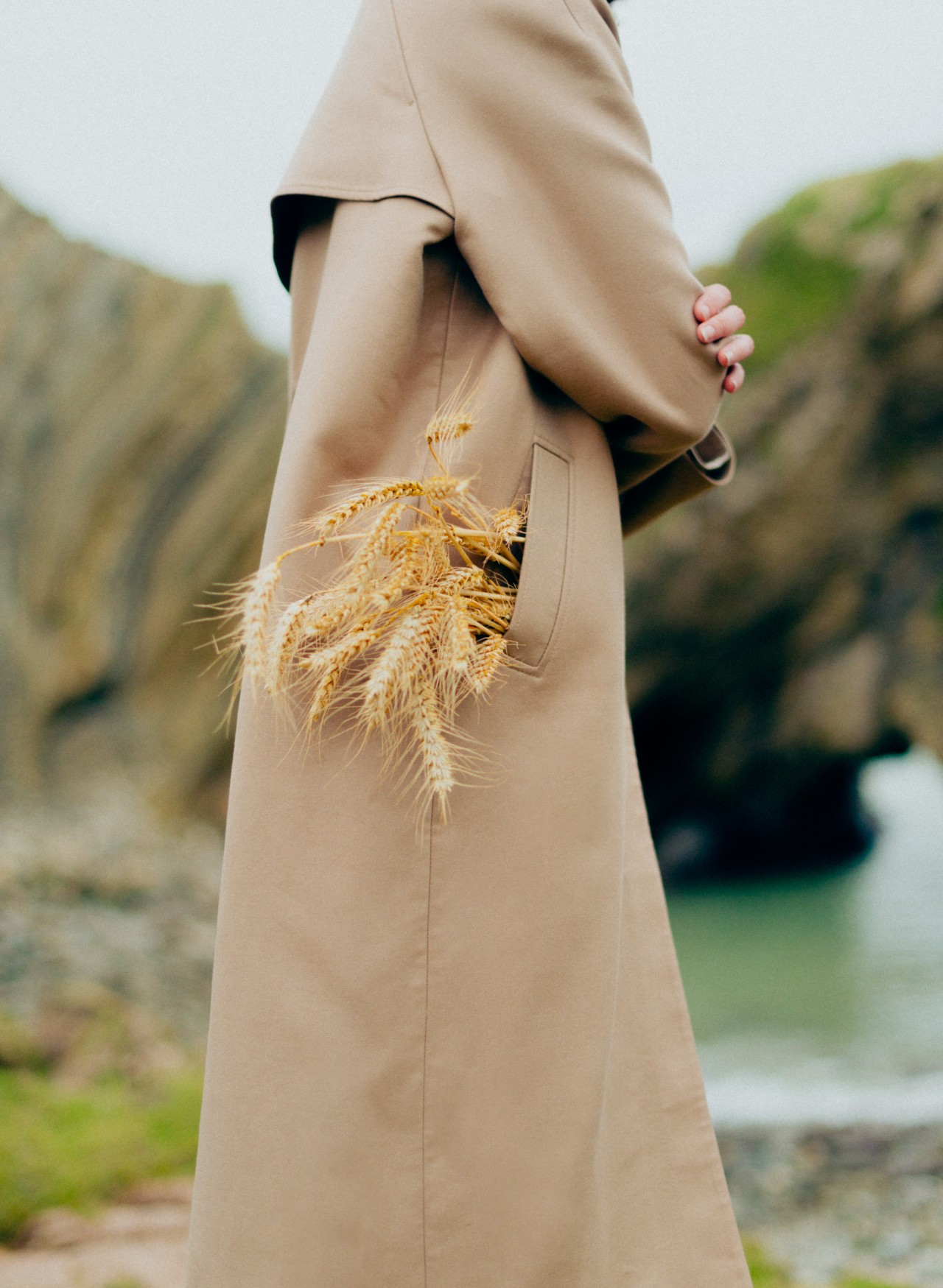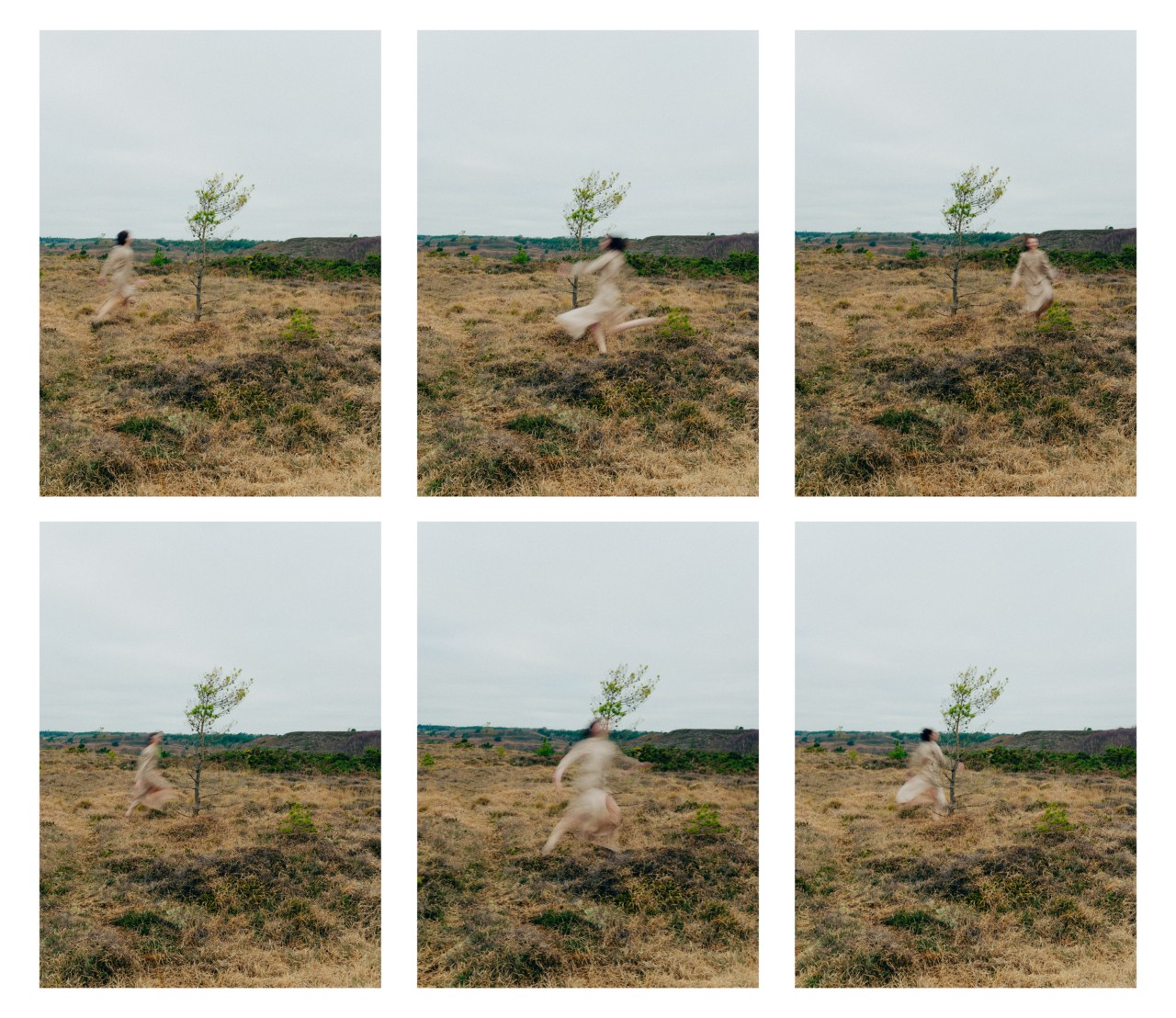

Words by Daphne Chouliaraki Milner
photographs by ashton hugh
Amy Powney was raised off the grid. With no running water and little electricity, she spent her childhood on a farm in northern England, and learnt firsthand what the beginning of a supply chain looks like.
So, when Powney joined Mother of Pearl—a womenswear brand founded by Maia Norman—fresh out of university in 2006, the knowledge that every item has an origin story was front of mind. “I understood where electricity came from because we had a wind turbine; I understood where water came from because we had a well,” said Powney. Nine years later, Powney was named creative director of the brand, a move that allowed her to shape not just the aesthetics of the brand, but also its ethics. Her aim was to create a fully sustainable brand from field to finished garment—a years-long journey that led to Fashion Reimagined, a documentary that chronicles the uphill struggle of prioritizing social responsibility in a system built on exploitation.
It’s a system that profits from forced labor and wage theft; pollutes waterways and drives deforestation; and reinforces a culture of disposability and waste. The average fast fashion garment is worn just seven times before it is discarded, a number that’s sure to drop as the rate at which we buy and consume clothes quickens. Yet, those same garments are made from fossil fuel-derived polyester and nylon, which can be traced back to prehistoric times, while others may well be made using wood pulp from thousand-year-old trees. It’s an origin story Powney insists is better understood and more widely recognized—only then can the industry begin to take responsibility for the scale of destruction it is causing.
“Humanity has only been on the planet for a speck of time—and we’ve caused so much damage within a speck of time, too,” said Powney. “It’s the same with polyester. It’s got this whole history of natural creation into a fossil fuel—and this moment where we extract it, process it, turn it into clothes, wear it, and bin it.”
Below, Powney speaks with Atmos about the urgent need to reframe our relationship to clothes by better understanding the ages-old histories of raw materials.



Daphne Chouliaraki Milner
I wonder whether you could just talk a little bit about how your journey at Mother of Pearl began?
Amy Powney
Next year, I’ll have been there at Mother of Pearl for 17 years. I started working at the brand fresh out of uni—and then, about 11 years ago, the woman who’d started it decided she didn’t want to work in it day-to-day. That was when I took over and decided it was my opportunity to do what I wanted with the brand.
As I started to grow the business, the industry was putting so much pressure on me to make more; to create more. My sales agents wanted more collections, more footwear, and more handbags. I was so burnt that I was like, “Surely this system isn’t good for anyone or for the planet?” It was at that point that I decided to really dig deep into the industry. I also won the British Fashion Council Vogue Designer Fashion Fund, which is the big award they give every year. And I decided that I was going to use the money from that on my mission: to get to the bottom of the supply chains and create the most sustainable version of my brand possible.
Seven years later, we’ve tried to incorporate everything we’ve learnt from our research and our work into how the brand operates. Once you understand the statistics and the way the system operates, it really is down to,“I have to change, otherwise I just don’t want to do it anymore.”
“Humanity has only been on the planet for a speck of time—and we’ve caused so much damage within a speck of time, too.”
Daphne
From your perspective, and drawing on your learnings from Fashion Reimagined, I wonder whether you could talk a bit about what the main challenges were for you on this journey?
Amy
The first part of the film follows my trip to Premier Vision, a big textiles fair—and I just assumed we would go and start speaking to suppliers and they would have eco ranges. This was seven years ago, and nobody had ever asked these questions about sustainability before. If it was cotton, is it organic? How’s it grown and what farms is it coming from? If it was lyocell, which forest is it coming from and how is it forested? If it was polyester and it was recycled, where was its root from? People looked at us like we were crazy. That was when we realized that it was not going to be easy.
The landscape is very different now, but the main challenge for us was that we were some of the first to ask the supply chain industry questions no one had been asking. We weren’t a big player, so we were hit with a wall of resistance. Because a lot of people who didn’t really understand or empathize with our mission just saw it as additional work to do.
The biggest challenge I’ve faced—and continue to face—is humanity. How many people want the same outcome as you? How many people are going to go the extra mile to help you achieve that outcome? In supply chains, you don’t just rely on one person. You rely on a chain of individuals and a chain of organizations. Everyone needs to work together. That applies to every industry—and climate change, too.

Daphne
Yes, you need people along the way who are going to work with you and collaborate with you—and crucially, who share the same values as you. That’s not done practice in this industry.
Amy
We’ve done a lot of work to overcome a lot of those challenges and integrate them into our whole working ethos as the brand, especially when it comes to our supply chain partners. The thing that I’m finding hard now is the other end. The face of fashion. There’s been a lot of conversations about hope in the last few years; conversations about change. We’ve also seen that the statistics on the amount of times sustainable fashion’s been used by online retailers has quadrupled. Yet, the figures aren’t changing. It’s about actually getting people to not greenwash; to reconsider the fashion system and take action.



Daphne
Speaking of reframing our relationship to clothes—in your TED talk, you highlighted that the age of the materials that make up the clothes we’re wearing have intricate histories of their own. Why is it so important that we recognize the histories of our garments?
Amy
I use the reference point of food. In the 1980s and 1990s, pre-made food was everywhere because it was quick and easy and convenient. But in the last 10 years or so, we’ve seen this movement of farm-to-table. People started understanding in the wellness space the importance of what we’re eating and how that affects our body. That’s why health food, organic food, and food that was good for the planet became not necessarily fashionable, but definitely more mainstream.
In fashion, we’re stuck in this marketing bubble that presents this glossy idea of fashion. Once it’s in a warehouse or with a brand, it shows up in advertising campaigns or in beautiful content through influencers, celebrities or red carpet dressing. Before that, it’s as if it doesn’t exist. No mention of where it came from. The fashion industry is so dirty that people just don’t want to see it and they don’t want to hear it. And yet, it wasn’t long ago that cloth was deemed as part of the experience of the wealth of the garment or the craft of the garment.
“The fashion industry has decided to keep the system dirty and hidden because it’s not in their interest to expose it.”
Amy Powney
In the face of climate change—and considering fashion’s impact on the climate—what we need to crack wide open and get people to understand is the root of clothes. We need to understand that the satin dress we like was actually a tree not that long ago. When we’re shopping, we need to be asking questions like: Where was the tree from? How old was it? What forest was it part of?
The same goes for fossil fuels, which make up so many of our clothes. Those materials were made pre-dinosaur. And we just extract them and we turn them into plastic or polyester—or we burn them. Usually age means expense, like with precious age stones, gold or wine. Anything that’s been in the ground for that long and we extract is usually deemed valuable. But fossil fuels are turned into cheap clothes that are thrown away after a few wears. These materials were made approximately 200 million years ago, and yet its whole design purpose is either for a piece of packaging; designed to go into a bin. The timeline is totally off.
Daphne
What do you think it will take to teach consumers to appreciate the history of the raw materials—and to create links between our garments and their origin stories?
Amy
Narrative and storytelling is the way to do it. The fashion industry has decided to keep the system dirty and hidden because it’s not in their interest to expose it. Because if they expose it, they need to change it. It’s the same as the fossil fuel industry: we need no new oil and gas fields because we need to move to renewables. But, there’s a chain of corporations and people profiting from it. The same goes for fashion. People are profiting from the extraction of natural resources and the exploitation of people for cheap prices, high margins, and profitability.
We need to apply the farm-to-table model to fashion in order to re-engage people with the origin stories of clothes and get them to reconnect. We need to establish a meaningful connection between consumers and their clothes on a mass scale. It must apply to the whole industry. What I’ve learned, though, is that where money and profit are lining the pockets of powerful men, the incentive for them to change is negligible.
So, it’s a double-edged sword. We need to change people’s relationships and we need to build momentum to force the people at the top to change. So, we need consumers asking the questions or shifting the way they shop. But, we also need brands to take more responsibility—and be held accountable.


Daphne
How does Mother of Pearl contribute to tackling this culture of disposability that we’ve been talking about?
Amy
My vision is still way more excessive than our actions because Mother of Pearl is a small company. We have 13 sustainable attributes. Those attributes show up on our site as a set of icons, including “sustainable forestry,” “raw but responsible,” and “keep it local.” Another is “traced from fiber to final,” which refers to the fact we have a certificate of origins of certified fibers. And it means we know where they’re spun, woven, dyed, and finished. This helps our efforts to try to keep our footprint as low as possible. It also helps to ensure that the process is localized to one or two countries, and that the processes are natural and organic.
Each of these sustainability criteria is attributed to a garment to show what we’ve achieved through that garment. It helps my team to have benchmarks and to know what they were working towards. And it also helps the customer to say, “What’s important to me? And, how can I implement that into my purchases?” They can then filter our site by size and color as well as by garments that are organic, made local, or have been recycled.

“The way I feel lately is that people congratulate me on my achievements, but nobody follows suit. Nobody’s listening.”
Amy
I’ve come to understand that circularity means life-centered design. This means integrating regenerative principles at every stage of your business, be it in the supply chain, office, or staff culture. Personally, I prefer the term “regenerative” over circular because it emphasizes ensuring everything taken is regenerated simultaneously. For example, if you’re sourcing cotton, consider how to regenerate through regrowth and soil improvement. When using trees for cellulose fibers, contemplate regenerating by replacing trees for everything taken.
It’s similar to the principle of wild camping—leaving no trace. In business, it’s about taking what you need while leaving no negative impact.
Daphne
Looking ahead, do you feel hopeful that the industry is capable of making the necessary changes in order to embrace and promote a more thoughtful, interconnected approach to clothing and materials?
Amy
I feel like people employ me or talk to me to be the beacon of hope—because I’ve “done it.” This has been a very raw and honest conversation with you—and I don’t even know it’s one to promote because I don’t know if it’s helpful. But, the way I feel lately is that people congratulate me on my achievements, but nobody follows suit. Nobody’s listening. I don’t feel like the industry is moving anywhere near at the speed that it should do. I don’t think accountability is speeding up in the way that we need. People aren’t taking responsibility for their actions or the exploitative systems they participate in.
We’ve had these conversations over and over again. It’s come to a point where I think legislation is our only hope.

Correction,
January 23, 2024 12:00 pm
ET
A previous version of this article mistakenly listed silk as being derived from a tree.
Why Some of Our Clothes Are Over 200 Million Years Old













